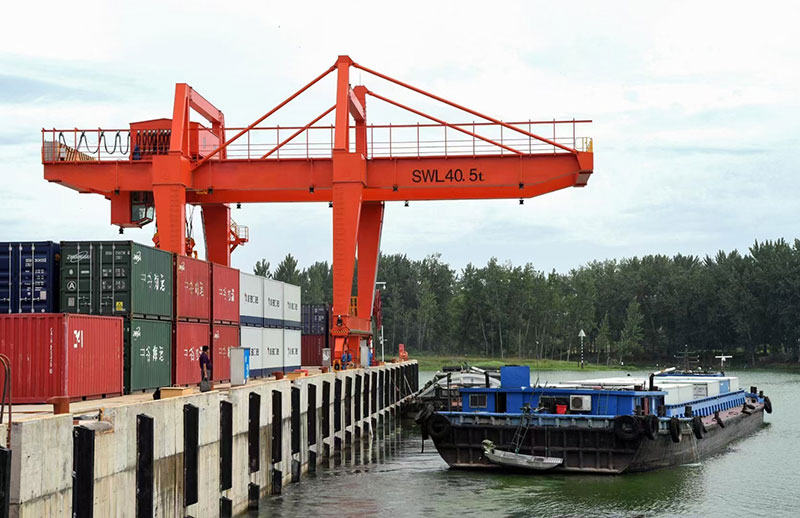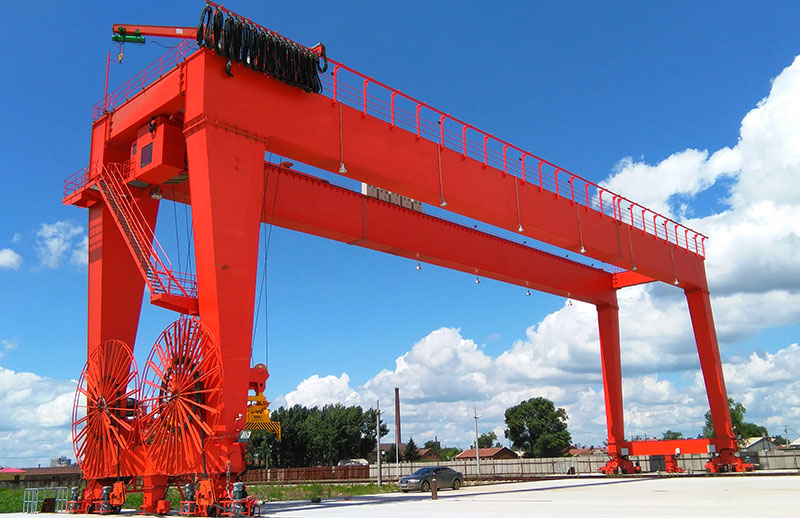Automated Rail Mounted Gantry (RMG) cranes are revolutionizing container handling at ports and terminals worldwide. With container volumes increasing and demands for faster turnaround times becoming critical, automated RMG cranes offer a powerful solution for boosting efficiency, improving safety, and reducing operational costs. In this article, we will explore how automated RMG cranes work, their key benefits, and the ways they are transforming container handling operations.

The Role of RMG Cranes in Container Handling
Rail Mounted Gantry cranes are a cornerstone of port and terminal operations. These automated rail mounted gantry cranes are typically used in container yards for loading, unloading, and stacking containers. Positioned on rails, RMG cranes provide precise, stable, and efficient movement, which makes them ideal for handling containers with great accuracy and consistency.
Traditionally, RMG cranes have been operated manually, with crane operators controlling the movement from a cabin or remotely. However, the introduction of automation technology has brought significant advancements in the way these cranes are operated, leading to a profound impact on overall operational efficiency.
What is an Automated RMG Crane?
An automated RMG crane is an advanced, intelligent system that uses automation technology to operate with minimal human intervention. These cranes are equipped with sensors, cameras, control systems, and artificial intelligence (AI) to perform tasks such as lifting, lowering, and stacking containers autonomously. They are integrated with terminal operating systems (TOS) and other logistics platforms to ensure seamless, synchronized operations.
The automation level can vary, from semi-automated cranes that still require some operator input to fully automated cranes that can perform all container handling tasks without human involvement.
Key Ways Automated RMG Cranes Improve Efficiency
1. Increased Throughput and Faster Operations
One of the most significant advantages of automated RMG cranes is the dramatic increase in throughput. Automation enables the Aicrane container gantry cranes to operate continuously and efficiently without the need for breaks, resulting in faster container handling operations. Automated RMG cranes can optimize their movements to minimize downtime between tasks, ensuring that containers are moved swiftly from point to point within the container yard.
Additionally, these cranes can execute multiple tasks simultaneously. For instance, while one crane is placing a container in the stack, another may be preparing to pick up the next container. This synchronization reduces waiting times and improves overall container flow.

2. Precision and Accuracy in Container Placement
Container stacking and retrieval require high levels of precision, especially when dealing with large volumes in busy ports. Human error in manual crane operations can lead to misalignment, damage to containers, and wasted time correcting mistakes. Automated RMG cranes, equipped with advanced sensors and cameras, can place containers with pinpoint accuracy.
The automated systems calculate the exact positioning required for each container, reducing the risk of improper placement. This precision allows for higher stacking, making better use of yard space and improving overall container storage capacity.
3. 24/7 Operations with Minimal Downtime
Automated RMG cranes can operate around the clock, enabling ports and terminals to function 24/7. Unlike human operators who require shifts, rest breaks, and other limitations, automated systems can maintain continuous operations without fatigue. This leads to significant increases in productivity, especially in ports with high container traffic where the ability to keep operations running smoothly is critical.
Additionally, the automation system is designed to predict and prevent breakdowns, further minimizing downtime. Advanced predictive maintenance technologies are integrated into these gantry cranes to monitor their health and performance, alerting operators to potential issues before they lead to costly downtime.
4. Reduction in Labor Costs
Labor costs can account for a significant portion of terminal operating expenses. Automated RMG cranes dramatically reduce the need for human operators, cutting down on labor costs associated with crane operation, maintenance, and supervision. This cost-saving benefit becomes particularly apparent in large container terminals where multiple cranes are in operation simultaneously.
While there are initial costs associated with purchasing and installing automated systems, the long-term savings in labor and operational efficiency quickly offset these expenses. Ports can reallocate their workforce to more strategic roles, improving overall management and operational oversight.
5. Enhanced Safety
Safety is always a top priority in port operations, and automated intermodal cranes offer significant improvements in this area. By reducing human involvement in the actual crane operation, the risk of accidents, injuries, and human error is minimized. Cranes equipped with automation technologies have advanced collision detection and avoidance systems, which ensure smooth and safe movement around other cranes, vehicles, and personnel.
These cranes are also equipped with real-time monitoring systems that can detect any unusual conditions, such as abnormal container sway or malfunctioning equipment, allowing for immediate corrective actions.
6. Optimized Yard Management
Automated RMG cranes, when integrated with terminal operating systems (TOS), offer better yard management capabilities. These intermodal cranes can communicate with the TOS to prioritize container movements, stack containers more efficiently, and plan routes that minimize congestion in the yard. The result is a more streamlined and organized yard operation, where container handling tasks are optimized based on real-time data.
This integration allows for improved planning and execution of container handling activities, which is especially useful during peak times or when managing urgent shipments.
The Future of Container Handling with Automated RMG Cranes
As global trade continues to grow and shipping volumes rise, the demand for efficient container handling solutions will only increase. Automated RMG cranes are set to play a pivotal role in the future of container handling at ports and terminals. By improving efficiency, reducing costs, and enhancing safety, these cranes are transforming the way container terminals operate, making them more competitive and better equipped to handle the growing demands of global commerce.
Automation also opens up the possibility of creating “smart ports,” where integrated, data-driven systems control every aspect of container handling. This level of automation can lead to further improvements in efficiency, as cranes, trucks, and other equipment work in harmony, all guided by intelligent control systems.
Conclusion
Automated RMG cranes have become essential tools for improving efficiency in container handling. From increasing throughput and precision to reducing labor costs and enhancing safety, the benefits of automation in RMG cranes are clear. As ports and terminals face ever-growing demands, automated RMG cranes offer a forward-looking solution that will continue to drive efficiency and productivity in the container handling industry for years to come.